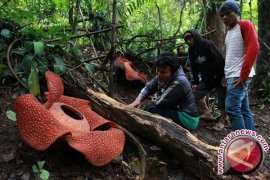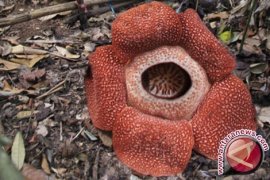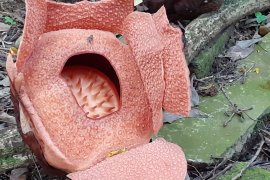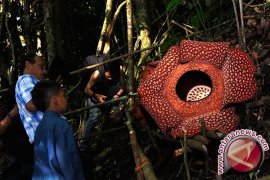Bengkulu (Antara Bali)- A total of 25 buds of Rafflesia flowers bloomed during the January-June 2015 period in Bengkulu Province, according to Coordinator of the Rare Flower Lovers' Community Sofian Ramadhan.
"Most of them bloomed in Bukit Daun protected forest," Ramadhan revealed here recently.
Other habitats of Rafflesia flowers include Taba Penanjung Sanctuary in Central Bengkulu District, and the forest area in Kaur District.
A Rafflesia arnoldii giant flower was found in full bloom on June 15, 2015, in Bukit Daun protected forest, Kepahiang District, Bengkulu Province.
The flower measures 80 centimeters in diameter and is estimated to be in full bloom for four days or until June 19, Holidin, a coordinator of the Rare Flower Lovers' Community in Tebat Monok, noted recently.
"There are some buds that are ready to bloom in the next few days, and we monitor them routinely," he added.
Bengkulu, which is dubbed "The Land of Rafflesia", is set to host an international symposium on Rafflesia and Amorphophallus flowers, the world's rarest and largest flowers, in September 2015.
The symposium, to be organized jointly by LIPI and the Bengkulu administration, was originally planned to focus on Rafflesia, but later the organizing committee decided to also include Amorphophallus, because much of the public cannot distinguish between Rafflesia and Amorphophallus flowers.
Discovered by Sir Thomas Stamford Raffles and British botanist Josepth Arnold in Bengkulu in 1818, Rafflesia is a parasitic flowering plant with no visible leaves, roots, or stem.
When in bloom, the Rafflesia emits a foul odour, similar to that of rotting meat, which gives this flower its local names of corpse flower or meat flower. This odour attracts insects, such as flies and carrion beetles, which transport pollen from male to female flowers.
The Rafflesia can only be seen when it is ready to reproduce. At this stage, a tiny bud forms on the stem of the vine, which develops for a period of nine to 12 months and resembles a cabbage. This cabbage-like bud will open to reveal the massive five-petaled flower, which remains visible for about one week.
The unique Amorphophallus titanium, commonly known as titan arum or the "corpse flower", is a large, fast-growing plant in the Aroid family. Few of these plants exist in cultivation and they bloom rarely and only under special conditions. (WDY)







